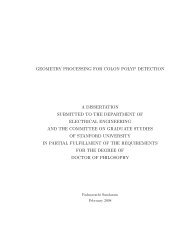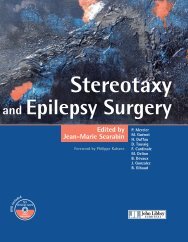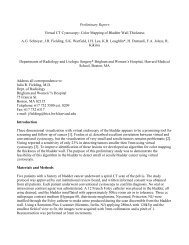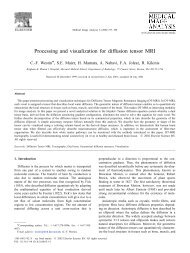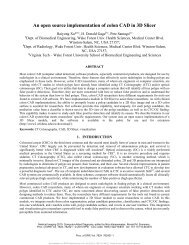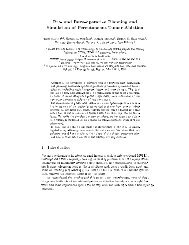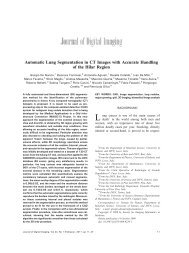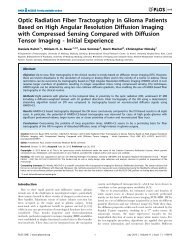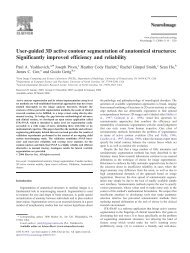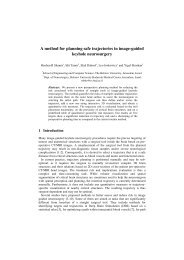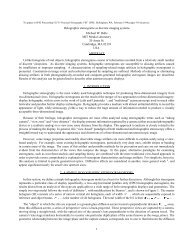BWH Manual (PDF) - INTRuST Neuroimaging Leadership Core
BWH Manual (PDF) - INTRuST Neuroimaging Leadership Core
BWH Manual (PDF) - INTRuST Neuroimaging Leadership Core
Create successful ePaper yourself
Turn your PDF publications into a flip-book with our unique Google optimized e-Paper software.
7. MRI Subject Scans for Clinical Trials7.1 MRI Scan Information Log1. The “MRI Scan Information Log” should be completed at the time of acquisition for every<strong>INTRuST</strong> subject. A copy of the MRI worksheet is included in Section 10.2 (Appendix 2).2. The study coordinator at the referral site should complete the top section of the MRIScan Worksheet. If this section is incomplete, please contact the study coordinator forthe information.3. The MRI technologist should complete the remainder of the form during the scan.Please be sure to indicate if each sequence has been completed and note any problemsor modifications to the protocol in the appropriate sections. This enables the NLC tomore closely follow each scanning session. Also, note if data transfer, archive, and localcopy for clinical reads have been completed.4. Please complete the form in full and transfer to the study coordinator at the referral site.The study coordinator will upload the information into the CNDA database and this willbe linked with the subject’s MRI data. Please keep a copy on site for your records.5. To report an incident regarding the MRI sequences, please email: MJC@bwh.harvard.edu6. To report an incident about a specific subject, please contact your study coordinator.7.2 <strong>INTRuST</strong> Subject Scanning Protocol for Clinical TrialsBefore the scan, perform these steps in order to use the correct diffusion file:1. Locate the file /usr/g/research/tensor.dat and rename it totensor_orig.dat2. Copy the <strong>INTRuST</strong> supplied tensor.dat to the location /usr/g/research/3. Once the scan is done return tensor_orig.dat to its initial name andlocation.Note: no adjustments should be made to this protocol. See section 8 of this manual for more details onthe following list of <strong>INTRuST</strong> suggested sequences. Scan all as "straight" - non oblique. See section5.4 for details on subject positioning. Please use padding around the subject’s head in order toprevent motion (use straps if available).1. Localizer2. ASSET Calibration Scan3. <strong>INTRuST</strong> suggested DWI sequence4. <strong>INTRuST</strong> suggested Structural Scan Sequence (T1)5. <strong>INTRuST</strong> suggested Susceptibility Weighted Imaging sequence6. <strong>INTRuST</strong> suggested Proton Density Scan7. <strong>INTRuST</strong> suggested T2 scan sequence8. <strong>INTRuST</strong> suggested Resting State fMRI (Subject should have eyes OPEN)NOTE: The NLC has supplied electronic protocols for installation by your local serviceengineer for your specific MRI system. This will ensure that you have the correct protocol foryour MRI scanner. The NLC QC team will check all imaging parameters to assure the correctsequence was used. If the electronically loaded <strong>INTRuST</strong> sequence is not used to scan asubject, the scan will be rejected and the subject must be re-scanned with the correct<strong>INTRuST</strong> sequences.7.3 Data TransferPlease upload all the data acquired for the MRI subject immediately after the scan iscompleted to the CNDA database as detailed in Appendix 5. See section 7.4 for instructionson the subject naming convention to be used for uploads to the CNDA. In addition, please savethe acquired data to CD/DVD and deliver to the local study coordinator along with the MRI



